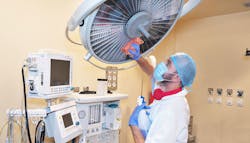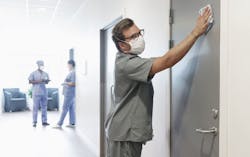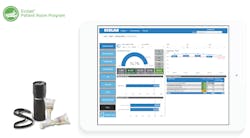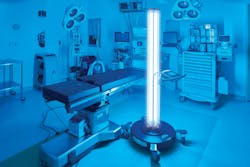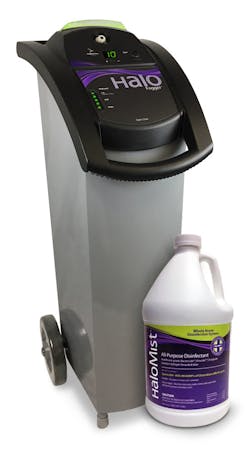As hospitals and healthcare systems march forward in care through the COVID-19 crisis and other public health emergencies, they must work together to keep their environments decontaminated, safe and approachable for patients.
“I spoke with Halosil customer Iris Verdi, EVS Director at Beebe Healthcare in Lewes, DE, about just that the other day,” shared Maryalice StClair, Chief Commercial Officer, Halosil International, Inc. “She feels that with the COVID-19 pandemic and the impending flu season, now more than ever, patients are concerned about safety when coming to a hospital. That fear keeps patients away from seeking treatment and can cost lives. Healthcare systems need to demonstrate that their facilities take patient concern seriously and are providing a safe, clean and sanitary environment.”
Two vital departments dedicated to the common goals of cleanliness, hygiene and protection from pathogens for patients, staff and visitors are environmental services (EVS) and infection prevention (IP) departments. They need to routinely perform high levels, monitoring and compliance of cleaning, sanitation, and infection control measures.
So, just how do COVID-19, the flu and other such major health events impact environmental cleaning, safety and quality in care? And how specifically do EVS and IP teams work to consistently create cleaner and safer operating, patient and common rooms, support personal hygiene and protective protocols, and, ultimately, help keep people safe from the spread of pathogens and infectious diseases?
Supporting EVS, IP staff needs
In order to safely and adequately perform their essential duties during COVID-19, EVS workers must have access to personal protective equipment (PPE), cleaning and disinfectant products and systems, and any other necessary resources and support.
“Of greatest importance is keeping EVS team members safe while working in what can only be classified as the front lines of a healthcare battle zone,” stated Mike Short, a Rubbermaid Cleaning Advisory Board Member and Director of Safety and Environmental Services at Maury Regional Medical Center.
Short continued, “Hospital EVS team members and other healthcare workers continue to test positive, which places additional burden on other exhausted and over-taxed team members. Facilities need to maintain a high level of training and open lines of communication with their staff, while not letting their guard down in completing the EVS mission of cleanliness and disinfection. One break or failure can have devastating consequences. This is where arming teams with products that are highly efficient and effective is critical. They provide an added level of assurance to both staff and patients that the job will get done.”
Yet, the ongoing crisis has caused significant personal and workplace strain on many healthcare personnel, stresses, Doe Kley, Senior Infection Preventionist, Clorox Healthcare.
“One of the biggest challenges is healthcare worker fatigue – fatigue with isolation, PPE, and general physical and mental fatigue,” Kley addressed. “Another challenge is staff who are not trained in cleaning and disinfection are increasingly being asked to take on this task during this resource-scarce time.”
“The exponentially higher demand for PPE and cleaning and disinfecting products has reshuffled the deck, with existing companies stretched to the limit and new players entering the market,” Martin emphasized. “It creates increased competition for already limited resources. The result is that many, if not all, healthcare facilities are in a situation where they will take anything they can get —and that’s not a position you wish upon those challenged with caring for others. We talk to hundreds of hospitals every day and we hear they are suffering. We’ve also reached out to foreign and domestic suppliers to ramp up production. We’ve made strategic moves to vertically integrate. We’ve invested in new machinery and expertise to maximize production of necessary cleaning, wiping and disinfecting products.”
High hygiene standard
Constant surface cleaning with the right products is required to create a safe environment, expresses Deborah Chung, regional marketing manager for Tork, Essity Professional Hygiene, North America.
“With typical flu season patient intake compounded by COVID-19 cases, hospitals’ and medical facilities’ staff are working tirelessly to maintain a safe environment that supports a high level of care,” Chung explained. “Given the pandemic-driven strain many facilities faced in 2020, EVS and IP staff continue to play a critical role in maintaining a high hygiene standard, so care providers can work effectively and know that stringent cleaning and disinfecting efforts are taking place to help prevent the spread of infection or cross contamination. In addition to hand hygiene, cleaning and disinfecting environmental surfaces, such as bedrails and door handles, is a fundamental part of hygiene protocols. The newly launched Tork Microfiber Cleaning Cloths provide options between disposable and reusable cloths for heavy and lighter duty tasks.”
For cleaning surfaces, the HYGEN Disposable Microfiber System is newly available from Rubbermaid Commercial Products, shares Michelle Olsen, Senior Product Manager, Rubbermaid Commercial Products.
“Our system is a perfect example in assisting EVS departments by removing 99.7 percent or more of tested viruses and bacteria1, 2 with water alone to help improve cleaning efficacy,” Olsen indicated. “The disposable nature of the cloths and pads encourages use of a new cloth or pad for each area to avoid cross contamination and is a direct response to the safety concerns highlighted by COVID-19.”
Larger volumes and adapted settings of care during the pandemic have elevated cleaning and disinfection responsibilities, observes Debra Hagberg MT (ASCP), CIC, Director, Clinical Affairs, PDI Healthcare.
“Makeshift ICUs, field hospitals, and triage areas expand the locations that require robust environmental disinfection,” Hagberg explained. “EVS personnel need to be flexible but competent in handling increased demand for services while maintaining compliance with appropriate PPE, disinfectant IFUs, efficient turnover of rooms, patient privacy, and waste management operations.”
Other surface cleaning products are offered by PDI Healthcare, including a majority of disinfectants that are included on the EPA List N, Disinfectants for COVID-19, continues Hagberg.
“PDI’s portfolio of environmental products offers a wide array of low to intermediate level, sporicidal, and continuously active disinfectants, and soft surface sanitizers in disposable wipes and sprays available in tubs, pails, and individual packages,” she shared. “PDI utilizes customer feedback when creating new products illustrated by the launch of Sani-HyPerCide disinfectants. This product was developed to satisfy customer requests for a non-bleach, sporicidal solution.”
Floors, in particular, are major high-contact sites for contaminants, addresses Nancy Huber, Product Manager, NoTrax.
“With the expansion of critical care units within (and sometimes outside of) the facility, the need for adequate environmental services and infection prevention has expanded,” Huber emphasized. “An early study by the CDC3 has shown COVID-19 is easily spread on floors. When they tested areas of the hospitals where no patients were present, like the hospital pharmacy, they had a 100 percent positivity rate for presence of the virus. Without a way to disinfect their shoes, critical care workers were tracking the virus across the hospital and out the door.”
Mats and shoe sanitizer systems by NoTrax can help to protect against pathogen spread from floors, points out Huber.
“The adhesive surface of the Clean-Step tacky mat traps dirt, germs, dust, and any kind of particulate that may be present on shoes or equipment wheels,” she indicated. “It can help prevent cross contamination by anyone moving through sensitive sterile areas, like ICUs. In addition to tacky mats, our zoned shoe sanitizer systems are great for simple shoe sanitizing before entering sensitive areas or when exiting contaminated areas. They have dedicated sections for cleaning, sanitizing and drying. These products can reduce the type of cleaning that needs to happen facility-wide because the mess is contained on the mats. It allows EVS professionals to focus on facility sanitation instead of sweeping.”
“Even in the best of times, only 30 to 40 percent of healthcare surfaces are cleaned and disinfected,” Kley stated. “Couple this with current challenges, resulting in a greater transmission risk, particularly of pathogens, such as influenza and C. difficile, which are easily transmitted via environmental services.”
Clorox Healthcare’s disinfectants and systems can be used facility-wide for comprehensive surface disinfection against many contaminants, adds Kley.
“At the start, Clorox Healthcare worked to get EPA approval for product claims against SARS-CoV-2, the virus that causes COVID-19, and as of today, nearly all Clorox Healthcare disinfectants have the SARS-CoV-2 claim,” she noted. “Our Clorox Total 360 System provides an efficient and effective way for healthcare facilities to disinfect waiting rooms, patient rooms and transport equipment. Clorox Healthcare also launched Clorox Healthcare Spore Defense Cleaner Disinfectant, available through the Clorox Total 360 System. Spore Defense is a low fragrance bleach that kills C. diff in five minutes in addition to 42 other pathogens, including influenza and SARS-CoV-2, and can be used in sensitive patient settings.”
Supporting hygiene compliance
COVID-19, of course, raised more attention on cleaning, hygiene and sanitation practices and infection control.
“At the onset of COVID-19, every health system had to evaluate its protocols to ensure it met the safety concerns related to the pandemic for team members, patients and the community,” said Linda Homan, RN, BSN, CIC, Senior Manager of Clinical Affairs, Ecolab Healthcare. “Despite waived inspection requirements and suspended infection reporting, maintaining vigilance with cleaning and hygiene standards grew increasingly important. Objective performance monitoring technology that provides real-time actionable data to identify potential gaps in cleaning and disinfection programs has been a help to hospitals, as they allow Infection Prevention teams to focus their time and resources on emergent COVID-19 needs.”
Ecolab Healthcare provides a comprehensive solution for environmental hygiene standard processes and protocols, training, and compliance to aid safety in care, shares Homan.
“The Ecolab Patient Room Program provides standardized cleaning workflows that help minimize the opportunity for objects to be missed and for pathogen spread, while improving operational cost savings,” explained Homan. “EVS and non-EVS personnel who are taking on a cleaning role have access to professional training based on industry best practices. And the Observational Survey Tool and DAZO Fluorescent Marking Gel provide objective methods to evaluate the thoroughness of cleaning processes and consolidate audit data. This provides visibility into the hospital’s process so EVS can pinpoint where corrective action is needed before errors put a patient at risk.”
Tork’s hygiene products and educational resources focus on helping EVS and IP staff achieve a high hygiene standard among staff and patients, Chung notes.
“Tork Clean Care, an online resource hub for healthcare and long-term care facilities, offers free, downloadable resources with education and best practices for EVS and IP teams, including surface cleaning resources, which is a critical component of any cleaning checklist,” Chung expressed. “Additionally, Tork Clean Care offers downloadable guides for how to strategically place hand sanitizer dispensers throughout facilities. Strategic dispenser placement can boost hand hygiene compliance by 50 percent4 – contributing to mitigating the spread of germs, viruses and other bacteria.”
She continued, “Tork PeakServe Continuous Hand Towel Dispensers can hold up to 2,100 towels per dispenser, helping reduce the time EVS staff spend restocking dispensers, and in turn, increase time hospital staff need to focus on maintaining a clean and safe environment in other areas. Tork offers a range of skincare formulations that maximize cleanliness while being mild on the skin.”
Enhancing room disinfection
During COVID-19, managing hospital and healthcare staff time and care settings are crucial for meeting the demand in care and preventing infections. Many facilities are looking to increase efficiencies in cleaning, disinfection and turnover of rooms, such as adding room disinfection systems to complement practices.
Trapani points to UV technology for helping to disinfect entire rooms in hospitals or healthcare facilities in rapid time.
“Mobile and fixed UVC disinfection systems that utilize UVC sensors to measure the actual or calibrated dose of UVC delivered to targeted surfaces in the space being disinfected offer the fastest possible treatment time while providing proof of compliance that the proper dose was actually delivered,” Trapani explained. “The RD UVC mobile system is easily deployed throughout all facility environments to help reduce airborne and surface contamination of harmful pathogens. The new RD-Fx fixed mount UVC system treats COVID-19 in two minutes between room uses. Environments that require rapid turnover and increased throughput between cases are able to provide UVC dose assurance for a cleaner and safer environment.”
Richard Hayes, President, UltraViolet Devices, Inc., adds how UV disinfection systems for whole rooms help support cleaning and ease staff that medical environments are safe and ready for care.
“The need to have technology in place providing reliable surface disinfection with as little disruption to their workflow as possible has been repeatedly expressed,” Hayes indicated. “We’ve also seen a spike in requests for HVAC systems to have automated UV disinfection technology in place to relieve concerns that the air systems can be contributing to the transmission of viral incidences. With hospital capacity stretched, turning over rooms quickly and safely is vital. For a typical patient room, the UVDI-360 requires two five-minute cycles (and one additional five-minute cycle for the bathroom). There is proven third-party validation of pathogen inactivation claims at times and distances indicative of whole room disinfection from independent laboratory testing and peer-reviewed published clinical studies.”
Another option for whole room disinfection and peace of mind for infection control in healthcare settings is fogging technology, suggests StClair.
One healthcare system, she notes, has used the fogging system to help disinfect many spaces, including those with SARS-CoV-2 exposure, supporting cleaner and safer care environments.
“Per Iris, at Beebe Healthcare, every patient room that has had a positive SARS-CoV-2 patient is treated with the Halo Disinfection System,” StClair stated. “In common areas where the system cannot be used, Beebe performs the same level of cleaning and disinfection and follow-up with electrostatic spraying utilizing an activated hydrogen peroxide-based EPA-registered N-listed disinfectant. These protocols are used in all areas including surgical areas, procedural areas, and even waiting rooms, as it is critical that Beebe provide the safest facility possible for everyone who enters.”
References
1. Based on third-party testing on VCT surface with water only | EPA Est. No 92100-CHN-1
2. † HYGEN™ Disposable Microfiber Mop Pads remove 99.91% of Feline Calicivirus (surrogate for norovirus), 99.99% of Common human coronavirus OC43, 99.99% of Pseudomonas aeruginosa (Pseudo), 99.91% of Clostridioides difficile (C. diff), and 99.97% of Methicillin-resistant Staphylococcus aureus (MRSA). HYGEN™ Disposable Microfiber Cloths remove 99.97% of Feline Calicivirus (surrogate for norovirus), 99.99% of Common human coronavirus OC43, 99.99% of Pseudomonas aeruginosa (Pseudo), 99.79% of Clostridioides difficile (C. diff), and 99.70% of Methicillin-resistant Staphylococcus aureus (MRSA).
3. CDC, Volume 26, Number 7—July 2020, Dispatch, Aerosol and Surface Distribution of Severe Acute Respiratory Syndrome Coronavirus 2 in Hospital Wards, Wuhan, China, 2020, https://wwwnc.cdc.gov/eid/article/26/7/20-0885_article
4. Thomas BW, Berg-Copas GM, Vasquez DG, Jackson BL, Wetta-Hall R. Conspicuous vs Customary Location of Hand Hygiene Agent Dispensers on Alcohol-Based Hand Hygiene Product Usage in an Intensive Care Unit. J Am Osteopath Assoc 2009;109(5):263-267.

Looking past the pandemic for cleaning and infection prevention success
HPN asked industry professionals what they envisioned as the future of IP and EVS needs and practices. Here are their thoughts and predictions.
“Among other things, 2020 taught us just how unpredictable the future can be. We do know the pandemic will continue into 2021. We don’t know what impact vaccines will have, or when. But I think it’s reasonable to assume that, at some point in the future, there will be a glut of product in the market. But prices won’t necessarily come down because that product will have been manufactured using source materials priced at peak. As far as practices are concerned, I believe the touchless trend will continue, even after the pandemic subsides.”
— Brian Martin, Acute Care Pharmaceuticals,
a Member of Hospeco Brands Group
“At some point, we will arrive on the other side of this pandemic. Once we all catch our breath, we need to take an inventory of the lessons learned. First, being the heightened awareness of the importance of both hand hygiene and environmental cleaning and disinfection – it is vital that we keep this positive momentum going. We have learned some hard lessons this past year and by now we should understand the critical importance of being continuously prepared for the next emerging microbial threat or pandemic. This preparation should include having the right products and technologies available.”
— Doe Kley, Clorox Healthcare
“SARS-CoV-2 is taxing the traditional infection control infrastructure. Recent publications suggest hospitals are experiencing an increase in some healthcare-associated infections as a result. The trend may continue unless resources are made available to maintain a consistent level of environmental cleanliness. Using a robust environmental hygiene program may help. To be effective, this programmatic approach should incorporate efficacious and efficient products, clear and evidence-based processes and training, and objective performance monitoring technology to provide real-time actionable data back to infection prevention staff.”
— Linda Homan, Ecolab Healthcare
“Needs and practices for EVS and IP personnel will intensify post-pandemic. I envision innovative technology and solutions being a must; perhaps increased automation so there is less dependency on human factors, innovative equipment/surfaces that have sustained antimicrobial effects, improved audit/surveillance tools for disinfection compliance, or improvements in surface compatibility materials or environmental design. I also see the increased need for strong relationships between IP and EVS. EVS personnel have eyes on the institution daily and can provide important feedback regarding potentially problematic situations before problems arise.”
— Debra Hagberg, PDI Healthcare
“In working with the Rubbermaid Commercial Products’ Cleaning Advisory Board, we believe there are several key areas of focus: protecting and supporting EVS staff, maintaining vigilance across all areas of the hospital—not just COVID units, and anticipating a potential shift towards disposable cleaning products with proven efficacy. Another important focus is working to ensure that facilities have adequate supplies of cleaning products and PPE to meet their needs. This was a critical issue earlier in the pandemic and one that Rubbermaid is prepared to address for the future.”
— Michelle Olsen, Rubbermaid Commercial Products
“COVID-19 will have an everlasting impact on hospitals and medical facilities. In 2021 and beyond, proper training for surface cleaning and hand hygiene will be key in ensuring EVS and IP staff are up to speed on proper hygiene protocols. We’ll continue to see the integration of technology in EVS and IP practices across training and products. Additionally, we’ll see technology implemented into physical products to improve efficiency.”
— Deborah Chung, Essity Professional Hygiene, North America,
part of Tork
“I and many healthcare professionals with whom I have spoken agree that COVID-19 may not be the last pandemic we see in our lifetime. In the past decade, every year has brought new and emerging pathogens. Many spore-producing bacteria are nasty pathogens, like Bacillus anthracis, the cause of anthrax and Clostridium difficile.”
— Maryalice StClair, Halosil International, Inc.
“Every industry is going to be concerned with how to keep their employees and consumers safe and because of that, products like our zoned shoe sanitizing systems, disinfectant mats, and shoe wash stations will become more commonplace. I think we’ve only scratched the surface of what our needs will become. The widespread nature of this pandemic, combined with a high threat of seasonal illnesses, has opened our eyes to a gap in the plan. This will eventually force companies to display their ingenuity and engineer more products to meet the needs of the healthcare industry and beyond.”
— Nancy Huber, NoTrax
“An important new need in healthcare environments is the ability to rapidly disinfect high-turnover procedure rooms and ORs between cases without a dedicated FTE. This requires high-powered fixed mount systems, that are not moved from room to room, which employ high-efficacy germicidal UVC at 253.7nm.”
— Sam Trapani, Steriliz UVC
“More seamless collaboration than ever. The example of PPE and N95 sourcing challenges underlines how core environmental safety equipment plays a key role in infection prevention. Products and devices that provide automated user data and analytics to empower in-the-moment efficiency, decision making and partnership between EVS and IPs are especially key.”
— Richard Hayes, UltraViolet Devices, Inc.
About the Author

Ebony Smith
Ebony Smith was previously Managing Editor for Healthcare Purchasing News.
